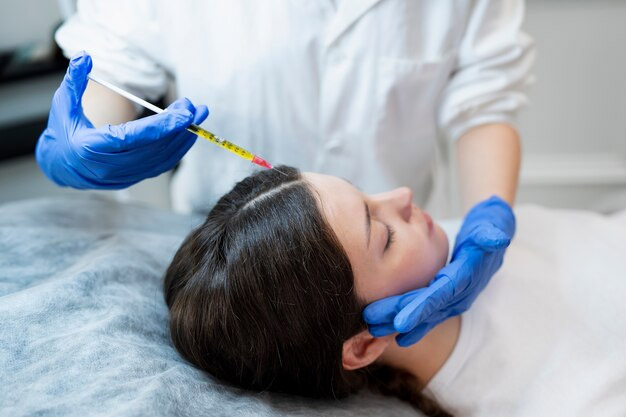
Introduction
Hair loss is a common concern that affects both men and women, often leading to a loss of confidence and self-esteem. Alopecia, a condition that causes hair thinning or baldness, can be triggered by genetics, hormonal imbalances, stress, or medical conditions. In recent years, Platelet-Rich Plasma (PRP) therapy has emerged as an effective, non-surgical solution for hair restoration.
PRP hair treatment is a natural approach that utilizes the body’s own healing properties to stimulate hair growth. This guide provides a complete overview of PRP Hair Treatment Abu Dhabi including how it works, what to expect, and its benefits.
What is PRP Hair Treatment?
PRP hair treatment is a regenerative therapy that uses the patient’s own blood to promote hair growth. The procedure involves drawing a small amount of blood, processing it to extract the platelet-rich plasma, and injecting it into the scalp. These platelets contain growth factors that help repair damaged hair follicles, stimulate new hair growth, and improve hair thickness.
This treatment is widely used for different types of alopecia, including androgenetic alopecia (male and female pattern baldness) and other forms of hair thinning. PRP therapy is a safe and minimally invasive procedure that harnesses the body’s natural healing mechanisms.
How PRP Hair Treatment Works
PRP therapy follows a simple yet effective process that consists of the following steps:
- Blood Collection: A small amount of blood is drawn from the patient’s arm.
- Processing the Blood: The blood is placed in a centrifuge, which spins at high speed to separate the platelet-rich plasma from other components.
- PRP Injection: The concentrated plasma is carefully injected into areas of the scalp affected by hair thinning or alopecia.
The growth factors in PRP help stimulate dormant hair follicles, enhance blood circulation to the scalp, and encourage new hair growth. Over time, this leads to improved hair density and thickness.
Who Can Benefit from PRP Hair Treatment?
PRP therapy is suitable for individuals experiencing mild to moderate hair loss. It is commonly recommended for those who:
- Have early-stage hair thinning or pattern baldness.
- Want to strengthen existing hair and prevent further hair loss.
- Prefer a natural, non-surgical approach to hair restoration.
- Are in good overall health and have realistic expectations.
A consultation with a hair specialist can help determine if PRP treatment is the right choice based on the individual’s condition and hair loss pattern.
What to Expect During the Procedure
PRP hair treatment is a straightforward procedure that typically takes about 45 to 60 minutes. The process includes:
- Drawing a small sample of blood.
- Processing the blood in a centrifuge to extract platelet-rich plasma.
- Injecting the PRP into targeted areas of the scalp using fine needles.
Since the procedure is minimally invasive, most patients experience little to no discomfort. A numbing cream or cooling technique may be used to enhance comfort during the injections.
Recovery and Aftercare
PRP hair treatment requires minimal downtime, allowing patients to resume their normal activities shortly after the procedure. However, for optimal results, it is recommended to follow these aftercare guidelines:
- Avoid washing the hair for at least 24 hours after treatment.
- Refrain from excessive sun exposure and heat treatments for a few days.
- Avoid vigorous exercise or heavy sweating for at least 48 hours.
- Follow the specialist’s advice regarding hair care and maintenance.
The scalp may feel slightly tender or appear red after the procedure, but these effects typically subside within a day or two.
How Many Sessions Are Needed?
PRP therapy is not a one-time treatment; multiple sessions are usually required for optimal results. A typical treatment plan consists of:
- An initial series of three to four sessions spaced a few weeks apart.
- Maintenance sessions every few months to sustain hair growth.
The number of sessions varies depending on the individual’s response to the treatment and the severity of hair loss. Regular follow-ups with a hair specialist can help track progress and make necessary adjustments to the treatment plan.
Benefits of PRP Hair Treatment for Alopecia
PRP therapy offers several advantages for those struggling with hair loss:
- Natural and Safe: Uses the body’s own healing components, reducing the risk of adverse reactions.
- Non-Surgical Solution: Requires no incisions, making it a minimally invasive treatment.
- Stimulates Hair Growth: Enhances hair density, strength, and overall scalp health.
- Quick and Convenient: The procedure is performed in a clinic setting with minimal downtime.
- Suitable for Various Types of Alopecia: Can be used for pattern baldness and other forms of hair loss.
Frequently Asked Questions
How soon can I see results from PRP hair treatment?
Results vary from person to person, but most individuals start noticing improvements in hair thickness and growth within a few months. The best results are typically seen after multiple sessions.
Is PRP hair treatment painful?
The procedure is generally well-tolerated, with only mild discomfort from the injections. A numbing cream or cooling technique may be used to minimize any discomfort.
Can PRP completely cure alopecia?
PRP therapy is an effective treatment for reducing hair loss and promoting new hair growth, but it is not a permanent cure for alopecia. Regular maintenance sessions may be required to sustain results.
How long do the results of PRP hair treatment last?
The results can last for several months to a year, depending on the individual’s hair growth cycle and overall scalp health. Periodic maintenance sessions help extend the benefits.
Can PRP be combined with other hair loss treatments?
Yes, PRP therapy is often combined with other hair restoration treatments for enhanced results. A hair specialist can recommend the best approach based on individual needs.
Conclusion
PRP hair treatment is a promising solution for individuals experiencing hair thinning and alopecia. By harnessing the body’s natural healing power, this non-surgical procedure stimulates hair growth, strengthens existing hair, and improves overall scalp health.







